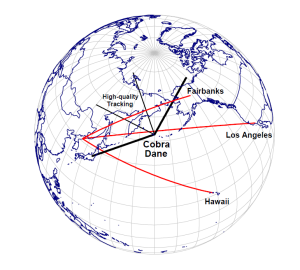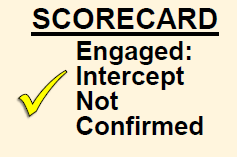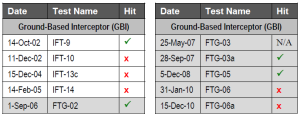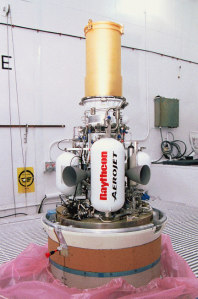Claims by U.S. government officials about the effectiveness of the U.S. Ground-Based Midcourse (GMD) national missile defense system. This iteration adds seven additional claims (some old, some new). In order to facilitate future updates, they are now in chronological rather than reverse chronological order.
(1) September 1, 2000: “… I simply cannot conclude, with the information I have today, that we have enough confidence in the technology and the operational effectiveness of the entire NMD system to move forward to deployment. Therefore, I have decided not to authorize deployment of a national missile defense at this time.” President Bill Clinton, at Georgetown University, September 1, 2000.
(2) March 18, 2003: “Effectiveness is in the 90% range.”[1] Edward Aldridge, Undersecretary of Defense for Acquisition, Technology and Logistics.
(3) March 23, 2003: “There are a lot of things that go into [determining] effectiveness. Everybody can be right.” [2] MDA Director Ronald Kadish, in response to a question about Aldridge’s statement.
(4) March 14, 2006: “When the president declares limited defensive operational capability, we are prepared as the shooter, if you will, to execute the mission to defend our country. And I’m very confident in the efficacy of that system.”[3] Admiral Timothy Keating, Commander of U.S. Northern Command.
(5) June 2006: “(From) what I have seen and what I know about the system and its capabilities I am very confident.”[4] MDA Director Lt. Gen. Henry Obering.
(6) July 6, 2006: “If it headed to the United States, we’ve got a missile defense system that will defend our country.” President George W. Bush in response to a question on Larry King Live about North Korea’s unsuccessful test of a long-range ballistic missile the day before.
(7) September 1, 2006: “I would say that if we had to use the system in an operational mode, it would be very capable.”[5] MDA Director Lt. Gen. Henry Obering.
(8) October 2, 2007: “ - does the system work? The answer to that is yes. Is it going to work against more complex threats in the future? We believe it will.” MDA Director Lt. Gen. Henry Obering.[6]
(9) November 2, 2008: “I have very high confidence we could defend the United States against that threat.”[7] MDA Director Lt. Gen. Henry Obering, about one or two missiles launched from North Korea.
(10) March 27, 2009: “And Senator, I’ll tell you, if we felt the North Koreans were going to shoot a ballistic missile at us today, I am comfortable that we would have an effective system able to meet that threat.”[8] General Victor Renaurt, Commander U.S. Northern Command, U.S. Africa Command and U.S. Transportation Command.
(11) June 9, 2009: “I think that the judgement and advice I got was that the 30 silos we have now, or are under construction, are fully adequate to protect us against a North Korean threat for a number of years.”[9] And “I have confidence that if North Korea launched a long-range missile in the direction of the United States, that we would have a high probability of being able to defend ourselves against it.” Secretary of Defense Robert M. Gates.
(12) June 16, 2009: Confidence that a North Korean missile could be shot down is: “ninety percent plus.”[10] MDA Director Lt. Gen. Patrick O’Reilly.
(13) June 18, 2009 (approximately): “I’d believe we have a reasonable chance” of intercepting a North Korean missile. Director of Operational Test and Evaluation Charles McQueary, in an interview on his last day in the job.[11]
(14) July 28, 2009: “Well, we have a very proven missile system in the area of missiles coming out of North Korea.”[12] MDA Director Lt. Gen. Patrick O’Reilly.
(15) April 21, 2010: “It is the belief of the — of the leaders of this department that we have the capability to defend the United States against the — against an ICBM threat from a rogue nation such as Iran or North Korea. We are confident in the system we have at this point.”[13] Geoff Morrell, Pentagon Press Secretary.
(16) December 1, 2010: “…the probability will be well in the high 90s today of the GMD system being able to intercept that today.” MDA Director Patrick O’Reilly in response to a question from Representative Trent Franks about countering “one ICBM coming from Tehran to New York.”[14]
(17) April 13, 2011: “The posture we have today is one that has us well-protected against the initial ICBMs that might be deployed by states like North Korea and Iran with — that are few in number, relatively slow and lack sophisticated countermeasures.”[15] Bradley Roberts, Deputy Assistant Secretary of Defense for Nuclear and Missile Defense Policy.
(18) December 12, 2012: “I’m very confident that American defense capabilities are able, no problem, to block a rocket like this one.” U.S. Secretary of Defense Leon Panetta, in response to a question from CNN on the capability of U.S missile defenses, December 12, 2012.[16]
(19) March 7, 2013: “I can tell you that the United States is fully capable of defending against any North Korean ballistic missile attack. And our recent success in returning to testing of the upgraded version of the so-called GBI, or the CE2 missile, will keep us on a good trajectory to improve our defense capability against limited ballistic missile threats such as those from North Korea. But let’s be clear, we are fully capable of dealing with that threat.” White House Press Secretary Jay Carney, in response to a question at White House Daily Press Briefing, March 7, 2013.[17]
(20) March 15, 2013: “We have confidence in our system. And we certainly will not go forward with the additional 14 interceptors until we are sure that we have the complete confidence that we will need. But the American people should be assured that our interceptors are effective.” Secretary of Defense Chuck Hagel, in response to a question at a Pentagon press conference, March 15, 2013.
(21) April 9, 2013: I believe we have a credible ability to defend the homeland, to defend Hawaii, to defend Guam, to defend our forward-deployed forces and defend our allies. Admiral Samuel Locklear, Commander, U.S. Pacific Command, Senate Armed Services Committee, April 9, 2013 in response to a question about intercepting North Korean missiles.[18]
(22) May 8, 2013: “We do have confidence in the ability of the ballistic missile defense system to defend the United States against a limited attack from both North Korea and Iran today and in the near future.” Lt. General Richard Formica, Commander of the U.S. Army Space and Missile Defense Command/Army Forces Strategic Command and Commander of the Joint Functional Component Command for Integrated Missile Defense, in response to a question from Senator Mark Udall about the capability of “our current GMD system to defend all of the United States, including the East Coast, against current and near-term ballistic missile threats from both North Korea and Iran?”[19]
(23) May 9, 2013: “The East Coast is well-protected as the result of — well, it was protected before the additional — and this additional ’14 provides additional protection both for anything from North Korea as well as anything from Iran should that threat develop.” Madelyn Creedon, Assistant Defense Secretary for Global Strategic Affairs, in response to a question from Senator Mark Udall (and referring to the recently announced plan to deploy 14 additional interceptors in Alaska).[20]
[1] BAYH: Let me withdraw the question and move on. I think you see where I was heading.
Let me ask you Mr. — Secretary Aldridge, about the effectiveness of the system that’s to be deployed in 2004 and 2005 in protecting against this developing North Korean threat — the 10 land-based missiles proposed for the end of fiscal year 2004 — how effective would they be against the North Korean missile if it were, in fact, launched against our country?
ALDRIDGE: Well, we think that it would be effective. Probably shouldn’t go into a lot of details of…
BAYH: Well, how do you define effective — 90 percent success rate — 75 — 50?
ALDRIDGE: Yes, sir — you would — and you — the way you could achieve these rates is you don’t have to fire just one interceptor per target, you could fire two, as we do in PAC-3.
BAYH: Of course.
ALDRIDGE: And so the effectiveness is in the 90 percent range. Of course, we want the effectiveness to be high enough that we never have to use these things. I mean, that’s the ultimate effectiveness is that they’re never used.
BAYH: There are — there are — there are — there are 10 going online in 2004 — 10 in 2005. The radar is not going to be available — when will that go into place — 2006?
ALDRIDGE: Well, General Kadish has probably got the specific dates for all of those. Let him…
KADISH: We’ll have radars online to handle the early warning and usefulness of the system in ’04, when we put the missiles on alert if everything works out all right. We’ll add the sea-based X-band (ph) if it proves out by — the following year — it’s currently scheduled by September of ’05.
BAYH: So, Secretary Aldridge, your testimony is that with the 10 interceptors going in at the end of fiscal year ’04 and the radar that will be online at that time, we would have a 90 percent effectiveness in shooting down a NATO (ph) Dong II?
ALDRIDGE: Well, it depends on — a lot depends on the continuation of the — of the test and the effective — this precise effectiveness numbers. But I would put — you know, as of today, the projected effectiveness would be in the 90 percent range.
Senate Armed Services Committee, March 18, 2003.
[2] Randy Barrett. “Lawmakers Question Effectiveness of Missile Defense System.” Space News, March 24, 2003, p. 6.
[3] Jason Sherman, “Experts Question U.S. System’s Ability To Intercept North Korean Missile,” Inside Missile Defense, June 21, 2006.
[4] Robert Burns, “Missile Defense Chief Confident in Ability To Hit Missile,” The Associated Press State and Local Wire, June 23, 2006.
[5] Pentagon Briefing, September 1, 2006.
[6] “DoD News Briefing with Gen. Renuart and Lt. Gen. Obering from the Pentagon, Arlington, Va.”, October 2, 2007.
[7] “Obama To Be Told U.S. Missile Defense Capable, General Says,” CNN.com, November 2, 2008.
[8] Senate Armed Services Committee, March 17, 2009.
[9] “I think that the judgement and advice I got was that the 30 silos we have now, or are under construction, are fully adequate to protect us against a North Korean threat for a number of years.”
“I was just in Fort Greely last week, and its an immensly capable system.” And one of the things that I think is important to remember is, it is still a developmental system. It has real capabilities, and I have confidence that if North Korea launched a long-range missile in the direction of the United States, that we would have a high probability of being able to defend ourselves against it.”
Secretary of Defense Robert M. Gates, Hearing of the Defense Subcommittee of the Senate Appropriations Committee, June 9, 2009.
[10] SEN Bayh: I’ve bumped up against my time limits here, but there was one final question. You’re briefing the President of the United States. He asks you based on — you know, he’s got to take into consideration what you’re doing in terms of facing these threats. He asks you if there is a rogue launch, what are the percentages that we’re going to be able to hit it and bring it down, what would you tell him?
GEN. O’Reilly: Ninety percent plus.
SEN. Bayh: Ninety percent plus confidence that we could — if there’s a rogue launch from North Korea, let’s say, we could intercept that target and bring it down?
Gen. O’Reilly: Yes. Sir.
Hearing of the Senate Armed Services Committee, June 16, 2009.
[11] Viola Gienger, “Gates: Take Defense Steps,” The Salt Lake Tribune, June 18, 2009.
[12] Gen O’ Reilly: ‘Well, we have a very proven missile system in the area of missiles coming out of North Korea. The testing we have done to date, we have a lot of testing still to do against all our capability in all scenarios, but in the scenarios out of North Korea, we have intercepted three times out of Fort Greely, Alaska. The missiles, we actually test them out of Vandenberg, but they’re up at Fort Greely. And then for Hawaii, we have multiple systems (inaudible). A theater high-altitude-area defense system, its an Army mobile system, and then we have the Navy Aegis system. And we also have the…” Margaret Brennan, “US Missile Defense Director Patrick O’Reilly on Bloomberg TV,” Bloomberg TV, July 28, 2009.
[14] Strategic Forces Subcommittee of the House Armed Services Committee, December 1, 2010.
[15] “Now what does that mean? The posture we have today is one that has us well-protected against the initial ICBMs that might be deployed by states like North Korea and Iran with — that are few in number, relatively slow and lack sophisticated countermeasures. And against this threat, we have the current posture of 30 GBIs and the expected enhancements to come in the defense of the homeland with the future deployment in 2020 time frame of SM-3 2B.” Opening statement of Bradley Roberts, Deputy Assistant Defense Secretary for Nuclear and Missile Defense Policy, Hearing of the Strategic Forces Subcommittee of the Senate Armed Services Committee, April 13, 2011.
[16] Bradley Clapper, “U.S. Hesitant in Condemning North Korean Launch,” The Associated Press, December 13, 2012.
[18] SEN. MCCAIN: Do you believe that we have the ability to intercept a missile if the North Koreans launch a missile, as is widely reported they would do in coming days.
ADM. LOCKLEAR: I believe we have a credible ability to defend the Homeland, to defend Hawaii, to defend Guam, to defend our forward-deployed forces and defend our allies.
SEN.MCCAIN: Do we have the capability to intercept a missile if the North Koreans launch within the next several days?
ADM. LOCKLEAR: We do.
[19] Hearing of the Strategic Forces Subcommittee of the Senate Armed Services Committee, May 9, 2013.
[20] Hearing of the Strategic Forces Subcommittee of the Senate Armed Services Committee, May 9, 2013.
![]()
![]()







































